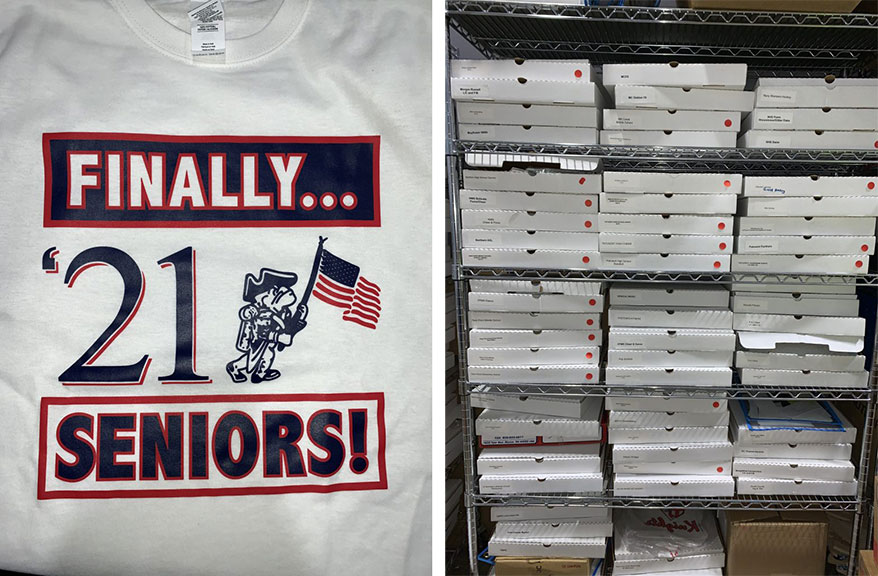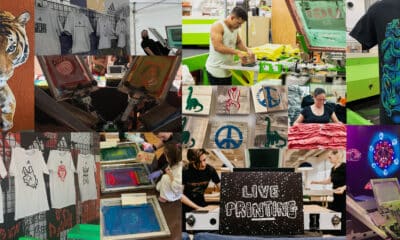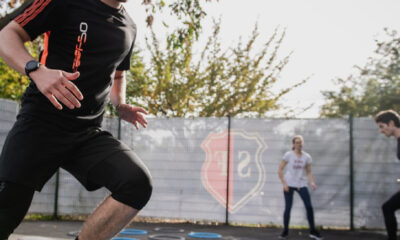Tips and How-To
Transfer Student: Is There A Place For Screen Print Transfers In Your Business Plan?
Let’s address some of the myths about this work.
Published
4 years agoon
I KNOW, I KNOW. I’ve heard it a hundred times. “If you use transfers, you’re not a reallll printer,” “you’re not a real business,” and my favorite, “you’re lying to your customers.” I’m here to set the record straight. There’s a niche for screen print transfers in your business. The question is, are you willing to explore the possibilities and learn about the opportunities?
Let’s address some of these myths. “If you use transfers, you’re not a real printer.” We all know there are a number of ways to decorate apparel. Embroidery, sublimation, HTV, traditional silk screen, DTG, and transfers. While each of these have their place in the industry, they also have their limitations and their niche. I’ve pulled a squeegee across thousands of screens, printing hundreds of thousands of impressions, and I still created more than 20,000 impressions using transfers last year. Next up, “you’re not a real business.” I kind of just shake my head at this one. Like most of us, I use all the tools in my chest to earn every penny
I can for my business. Choosing to use transfers does not mean it’s a hobby, it means I’ve found a revenue stream and a niche that meets a customer need. Lastly, “you’re lying to your customers.” Nope, not at all. In the same manner, I explain the pros and cons of every decoration method. I also explain the pros and cons of transfers, allowing my customer to make the best decision for their project, timeline, and budget. So, let’s see if silk screen transfers are a fit for your business.
Finding the Niche for Your Shop
Have you ever asked yourself, “How am I going to compete with Amazon? How can I ‘out Amazon, Amazon?’” I need to have an ecommerce presence, with a quality product, that’s reasonably priced (notice I didn’t say cheap – just reasonable), and I have to be able to ship not just fast but LIGHTNING FAST. If you’re printing using traditional silk screen or even DTG, good luck.
Let’s look at silk screening a single shirt to ship to your ecommerce customer. To keep it simple, let’s pretend you’ve printed this design in the last week and you saved your screens. The design has three colors in it. You grab your screens; perhaps they’re already taped up. You put them on your press and begin registering the screens. I know you have an awesome registration system so this is pretty easy. But let’s be honest, you still have to fine-tune the registration. Next, you find your ink colors, clean squeegees, and a shirt to test on. For the benefit of making this fast, let’s even say you have your flash and dryer already set at the correct temperature and your pallets are ready to go. You sling that shirt on the pallet like the pro you are. Once around, twice around, three times around – okay you have an auto – and you can print wet on wet. Print, flash, print, print, print… Nope. Registration is slightly off. Okay, registration is set, you grab the customer’s shirt, print, flash, print, print, print, pull the shirt, through the dryer – done. Wait.
You just spent 15 minutes minimum setting up a press to print one shirt and you’re only charging $15. I think you just lost money. Oh wait – you’re going to DTG that shirt. Do you have a stash of shirts already pre-treated? Yes? Great – grab the shirt, set up the file, and put it in the machine. Five minutes or so later, the shirt comes off the printer and you put it through your dryer. Your cost is much higher so you’re now charging $20-25 for a basic cotton shirt.
AdvertisementWatch Ali print a transfer below:

T-Shirt printed sample || WYSW’s filing system.
Now, let’s look at the case for transfers. Same situation: your order comes in from your ecommerce store. You grab the shirt, you walk over to your file system (in our shop it’s pizza boxes filed in alphabetical order), you grab the transfer you need, you walk over to your heat press, place the transfer on the shirt, and press for 8 to 12 seconds. All done in two minutes, with no clean up, and for less than $3. To date, our record is 18 minutes from the time we received the order to the time we notified our customer their order has shipped. That is how to out Amazon, Amazon.
Have you ever wanted to print on sight, but don’t have the ability to transport and set up equipment? This is another great niche for transfers. With a few boxes of blanks, a heat press, and some transfers you’re all set to print onsite without having to print items you may end up getting stuck with. State championships, gymnastics, track, cheer, and dance competitions, concerts, or any venue with 300-plus people in attendance has the potential to be a great opportunity for onsite printing. Here are a couple of tips to boost your sales. Get transfers that are specific to the event. However, I recommend not putting a specific date on them. Due to weather and many other factors (COVID-19, for example), events may slip by a week or even a month and you may lose money. If you’re able, get a roster of names of the participants. Market this as an add-on back print. Everyone loves to see their name on a T-shirt. Lastly, get a few transfers with generic sayings. If you’re printing for a sporting event, print a sheet with events, positions, or related terms. Use these as sleeve or alternate location prints. Put lots of them on one sheet and cut them apart. You can use a file box or an over-the-door shoe caddy to keep them sorted and easy to grab during the event. Participants will easily pay an extra $5, instantly increasing your profits.
What to Consider in Purchasing Transfers
Have I convinced you yet? Fantastic – let’s talk about the nuts and bolts of transfers. Transfers have come a long way in the last 10 years. Now there are various formulas to meet the needs of the vast materials used in apparel. There’s a wide range of quality, and a wide range of prices. In today’s market you can certainly find a transfer for just about any application and budget. While the various manufacturers may use different names to define their product, the formulas are very similar. First there are the Varsity, Athletic, Goof Proof, or Traditional transfers. These transfers are very versatile with the ability to be used on cotton, blends, or polyester. They wash well and are super easy to apply. They have some stretch to them and are a nice general, all-purpose transfer. These formulas come in one-, two-, three-, or full-color transfers and can be as little as 15 cents for a single-image, one-color transfer to as much as $3 for a single-image, full-color transfer. They generally press at around 325 degrees for 8 to 15 seconds. Be sure to follow the specific manufacturers’ instructions.
AdvertisementThere are also vintage, classic, or fashion formulas. These generally have a softer feel and a matte finish. They’re a bit more expensive, but have similar application instructions. They’re best for cottons and wash well. There are also many specialty formulas, such as glow in the dark, reflective, metallic, glitter, neon, nylon, and polypropylene. Each of these formulas vary in price and application based on the manufacturer. They also have their niche. Reflective transfers are great to market to police, fire departments, and running and biking clubs.
Watch this transfer completed in less than 30 seconds.
Have you ever been truly frustrated trying to print a windbreaker or a team jacket? If you don’t own jacket hold downs for your press, a nylon transfer may allow you to print that job easily without a large investment. The same thing goes for the recycled polypropylene bags. Many organizations and non-profits love to use these bags as giveaways. But if you don’t have the equipment or correct ink, they’re a challenge to print. Polypropylene transfers make this a quick and easy job, and open up another revenue stream for your business.
So, what do you think? I know you still love to pull a squeegee, but have I convinced you there’s a revenue stream and niche for silk screen transfers within your business? If you have questions or need more information, you’re always welcome to reach out to me at alison@mosdinc.com. There are many manufactures just waiting to pick up the phone and provide you samples of their work. Give it a try; what do you have to lose?
How to Choose the Right Manufacturer
There are many reputable transfer manufacturers. The best transfer company is the one that fits your market, budget, and needs. But how do you decide? Here are the key factors to consider when selecting a manufacturer.
Quality: Call around to the various vendors and request a sample pack. They will gladly send you some stock transfers of all their formulas. If they aren’t willing to do this, move on and choose someone else. When you receive the sample pack, press them on a shirt following the manufacturer-recommended time, temperature, and pressure. Wash the shirt a few times and see how the transfer feels and holds up.
AdvertisementTimeliness: Consider the company’s promptness. How quickly do they turn their orders around and get them shipped out to you? Most companies have a mid-day cut off time. If they receive your order before that time, they’ll generally print and ship the next business day.
Shipping: Once shipped, how long will it take to get to you? With the number of manufacturers, you should be able to find a reputable one with a two-day ship to your location. Don’t forget to ask if they offer free or reduced shipping if you order a certain amount. Several companies will give you free shipping if you order more than $250 in transfers. There are others that will bump your shipping up to over-night delivery for the price of ground shipping depending on your order size.
Research: Are you at a loss of where to look and who to trust? Hop on social media and don’t be afraid to ask questions. While you’ll get a lot of opinions, you’ll also get a lot of good information and more knowledge on the right questions to ask.
Odds and Ends
Heat Presses: It’s important to have a good press with a large clean surface area. You want to be able to easily adjust the time, temperature, and pressure. We’ve found that a digital readout press offers the best and most consistent product. You also need to be sure your press holds an accurate and consistent temperature. Some older or lower-quality presses will lose 5 to 10 degrees of temperature with each press. If time is money, you’re spending a lot of it waiting for your press to heat back up between presses.
Storage: You want to store your extra transfers in a flat, cool, dry location. We’ve found that large pizza boxes (unused, of course) work ideally for storing and protecting transfers when not in use. We have them stacked horizontally in alphabetical order on shelves. This keeps them flat and easy to locate in order to turn those jobs quickly. Generally speaking, transfers will last 12 to 18 months from the time they’re printed.
Printing rates: Are you trying to figure out the cost of transfer? One factor is how fast you can print or how many impressions you lay down in a given amount of time. This question is similar to asking how many shirts an hour can you screen print? It will depend on your equipment and operator. That being said, on average in our shop, with a swing away, air-driven, single platen press, we can do about 120 impressions an hour. Similar to running a silk screen press, fatigue can become a factor, and speed and accuracy is dependent on the operator.
Ali Banholzer is the owner of Wear Your Spirit Warehouse.

SPONSORED VIDEO
Let’s Talk About It
Creating a More Diverse and Inclusive Screen Printing Industry
LET’S TALK About It: Part 3 discusses how four screen printers have employed people with disabilities, why you should consider doing the same, the resources that are available, and more. Watch the live webinar, held August 16, moderated by Adrienne Palmer, editor-in-chief, Screen Printing magazine, with panelists Ali Banholzer, Amber Massey, Ryan Moor, and Jed Seifert. The multi-part series is hosted exclusively by ROQ.US and U.N.I.T.E Together. Let’s Talk About It: Part 1 focused on Black, female screen printers and can be watched here; Part 2 focused on the LGBTQ+ community and can be watched here.
You may like
Advertisement

Inkcups Announces New CEO and Leadership Restructure

Hope Harbor to Receive Donation from BlueCotton’s 2024 Mary Ruth King Award Recipient

Livin’ the High Life
Advertisement
Subscribe

Bulletins
Get the most important news and business ideas from Screen Printing magazine's news bulletin.
Advertisement
Most Popular
-

 Art, Ad, or Alchemy1 month ago
Art, Ad, or Alchemy1 month agoF&I Printing Is Everywhere!
-

 Case Studies1 month ago
Case Studies1 month agoHigh-Density Inks Help Specialty Printing Take Center Stage
-

 Andy MacDougall1 month ago
Andy MacDougall1 month agoFunctional and Industrial Printing is EVERYWHERE!
-

 Editor's Note1 week ago
Editor's Note1 week agoLivin’ the High Life
-

 Columns2 weeks ago
Columns2 weeks ago8 Marketing Mistakes Not to Make When Promoting Your Screen Printing Services Online
-

 Thomas Trimingham2 months ago
Thomas Trimingham2 months ago“Magic” Marketing for Screen Printing Shops
-

 Marshall Atkinson1 week ago
Marshall Atkinson1 week agoHow to Create a Winning Culture in Your Screen-Printing Business
-

 Press Releases2 months ago
Press Releases2 months agoBig Frog Custom T-Shirts & More of Round Rock Celebrates Grand Opening












